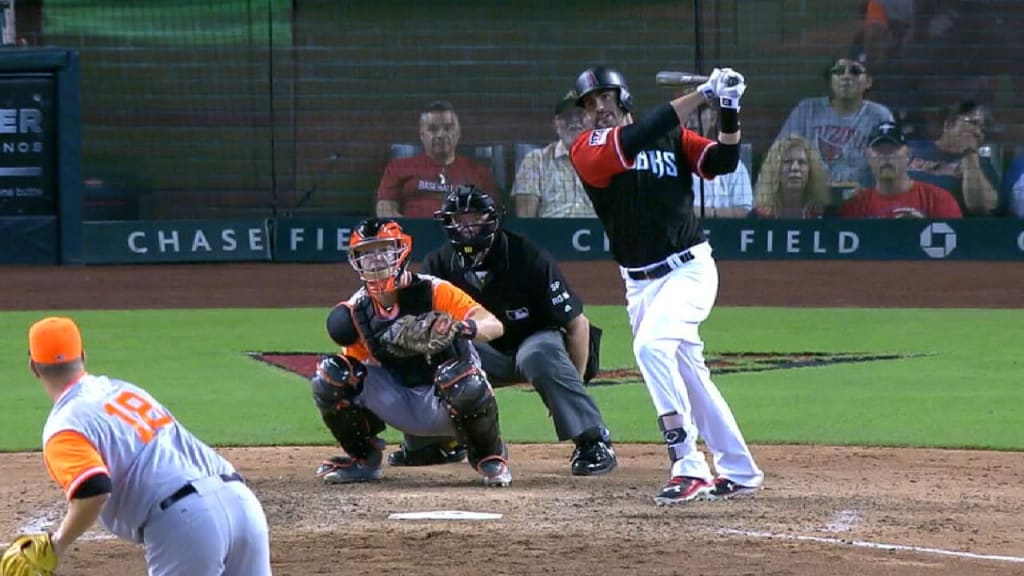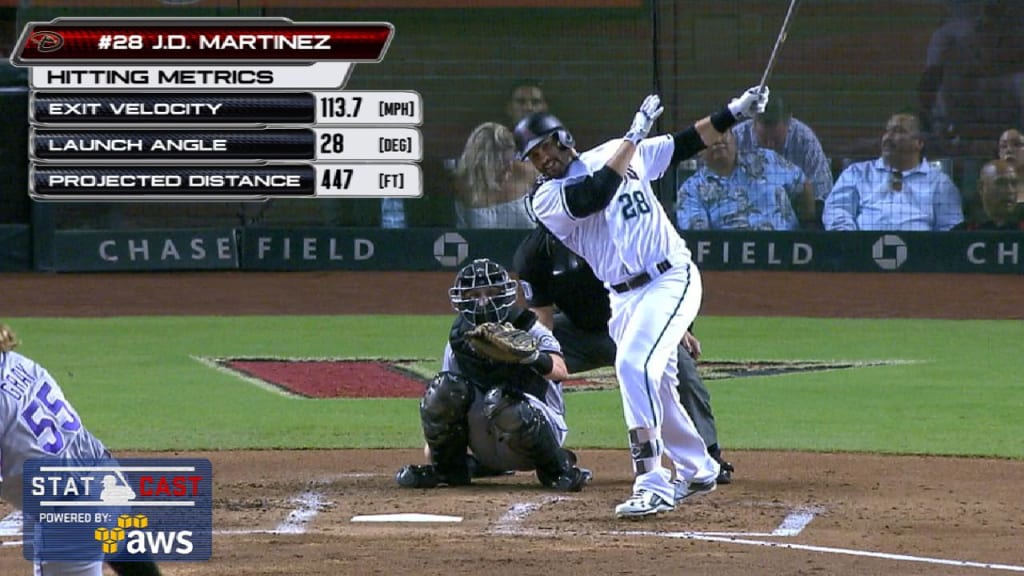History says Martinez's 5-year outlook is strong
This browser does not support the video element.
J.D. Martinez is easily the most elite bat available on the free-agent market, and it's not even really close. Yet with just weeks remaining before Spring Training begins, Martinez remains unsigned, though he's reportedly received offers of five years and in the range of $100 million to $125 million.
It's not hard to see why Martinez is looking for a historic contract, thanks to that bat. He's coming off a massive .303/.376/.690 (166 wRC+) season, which made him (on a rate basis) the third-best hitter in baseball, and this wasn't something new. Over the past four seasons, Martinez's line of .300/.362/.574 (148 wRC+) has him tied with Bryce Harper and Paul Goldschmidt as baseball's fourth-best hitter. At the plate, he's a stud. This is not arguable.
But it's not hard to see why teams are hesitant to hand out the six- or seven-year deal Martinez apparently wants, either. He is already 30, at a time when the sport has been trending to youth. Martinez is not a strong fielder, as he's piled up minus-27 Defensive Runs Saved and minus-15 Outs Above Average in 2016-17, and he's likely headed to a designated hitter role sooner than later.
The point is, it's a little complicated to know what Martinez's future holds. How can we guess how he might produce as he ages? By looking back to find similar players and see how they aged into their 30s, just as we recently did for Lorenzo Cain.
In order to find those comparables, we need to set some ground rules. We're looking back to find outfielders who put up stellar offense without strong defense, and we're trying to find those who did it over the last few years of their 20s. We're not considering career stats, because Martinez famously struggled for the first few years of his career with Houston (.251/.300/.387, 87 wRC+) before completely revamping his swing.
This browser does not support the video element.
So in order to achieve that, we looked back over the past four decades to 1977, and we looked only for retired or unsigned outfielders who did the following in their age 27-29 seasons.
• wRC+ over 135 (to find elite hitters)
• Slugging percentage over .500 (to find only true power bats)
• Negative defensive value (per FanGraphs)
That gave us 21 names. It's a fascinating list. There are Hall of Famers, All-Stars and those who were close to the end of the line.
Bobby Abreu
Albert Belle
Lance Berkman
Adam Dunn
Cliff Floyd
Kirk Gibson
Juan Gonzalez
Shawn Green
Pedro Guerrero
Vladimir Guerrero
Josh Hamilton
Matt Holliday
Kevin Mitchell
Dale Murphy
Magglio Ordonez
Dave Parker
Kirby Puckett
Manny Ramirez
Gary Sheffield
Danny Tartabull
Bernie Williams
There are a lot of different outcomes here. Let's see how this group aged, both in terms of good/poor outcomes and simply year-by-year.
Though some of these players continued to play into their 40s, that doesn't matter much right now. No one expects Martinez to sign a 10-year contract. Since the sticking point seems to be a contract between five and seven years, let's first look at performance between ages 30 and 35, or six seasons.
Best-case scenarios
If we consider a season of 3 Wins Above Replacement to be an above-average year, then six of our players averaged at least 3 WAR annually over the remaining six years: Sheffield, Berkman, Holliday, Ramirez, Abreu and Williams. Call this a very good outcome. Berkman made three All-Star teams after 30 while hitting 186 home runs, though he played far more first base than outfield in his 30s.
Holliday is actually a fantastic comparable because he entered free agency at the same age as Martinez and led up to it with a similar three-year wRC+ (145) as Martinez has (147). He signed a seven-year deal worth $120 million with St. Louis and was an above-average hitter (though not fielder) each year for the length of the deal.
This browser does not support the video element.
Worst-case scenarios
Health is obviously a concern as players age, and while Martinez isn't considered injury-prone, he has had two serious injuries in the past two years, breaking his elbow in 2016 and missing the first few weeks of '17 with a sprained foot.
Among our group of players, a few struggled to stay healthy. Belle played his final game at 33 due to a hip injury. Hamilton's final full season was at 32, thanks to multiple knee and shoulder surgeries, though obviously his off-field issues make him a unique case. By age 35, Dunn, Belle, Tartabull, Hamilton and Green were all out of baseball, and Puckett and Gonzalez were playing their final seasons.
As far as production goes, every single player remained an above-average hitter through 35, though of course that obscures two things. First of all, "above average" may be useful, but it can also be a big step back from present-day stardom. Second, declining defense can hurt overall value. Floyd, Gonzalez, Mitchell, Parker, Green and Tartabull were all worth less than 10 WAR between 30 and 36.
Here's how our group performed in their 30s, year by year.
At age 30
Averages: .290/.369/.516, 24 HR, 128 games, 544 PA, 132 wRC+, 3.1 WAR
Stardom, mostly. Fourteen of our 21 players hit at least 20 homers, while Berkman and Guerrero each had third-place MVP Award finishes. Every player had an above-average offensive season, though injuries affected several. Guerrero and Ordonez missed significant time due to knee injuries, and Mitchell got into just 99 games due to rib and foot problems.
Overall, this was a successful year, though it marked the end of Tartabull's time as a regular outfielder and the beginning of his tenure as a primary DH.
At age 31
Averages: .294/.378/.518, 27 HR, 135 games, 576 PA, 134 wRC+, 3.6 WAR
This was a very good year for Gibson, who took home the 1988 National League MVP Award, and for the group as a whole. Nine slugged over 30 homers, and 15 put out 20 or more. No one (with one exception) had a poor hitting season, and for the most part, everyone stayed healthy and productive. Nineteen of the 22 hitters in our group received at least 450 plate appearances. This was the final time Gonzalez played a full year, and the last time Murphy had a star-level season.
The outlier here was Dunn, who suffered through a miserable .159/.292/.277 (60 wRC+, -2.9 WAR) in his first year with the White Sox.
This browser does not support the video element.
At age 32
Averages: .283/.367/.491, 24 HR, 137 games, 582 PA, 126 wRC+, 2.9 WAR
Another solid season overall. Puckett finished second in the 1992 American League MVP Award voting, and Berkman finished fifth in the 2008 NL MVP Award ballot. Those two, along with Williams, Sheffield, Holliday and Mitchell all had star-level (4 WAR) years. Dunn bounced back to crush 41 homers, though since he was now a DH, it was worth only 2 WAR.
Again, health was relatively strong here. Only Gibson (hamstring), Gonzalez (calf) and Tartabull (ribs) failed to get into 100 games due to injury.
At age 33
Averages: .283/.361/.475, 22 HR, 137 games, 577 PA, 122 wRC+, 2.2 WAR
Mitchell took a year off to play in Japan, while the remainder of our group began to show some large divisions. Ordonez had his best year, hitting .363/.434/.595 (8 WAR), and Williams, Sheffield, Holliday, Abreu and Guerrero all had 3 WAR or better seasons. Berkman, Gibson, Ramirez and Guerrero were more or less average.
But of our 20 active names this year, half suffered through poor years, and they mostly looked identical. Belle (104 wRC+, 0.9 WAR), Parker (101, 0.9) and Dunn (107, 0.3) combined average offense with little defense, limiting overall value. Belle retired after the season.
At age 34
Averages: .269/.361/.445, 17 HR, 109 games, 448 PA, 116 wRC+, 1.5 WAR
Tartabull played in just three games before an injury ended his career. We have to account for the possibility that this is a potential path for Martinez, too, so their absences are included. Fourteen others had below-average seasons, some due to negative defensive value bringing down decent offense (Abreu, Ordonez), others being injured (Gonzalez, Hamilton), and some simply not hitting (Murphy). Dunn, Hamilton and Green were finished after this year.
There were a few success stories, though. Holliday put up his final above-average year (3.4 WAR), while Sheffield and Parker each had Top 3 finishes in the MVP Award voting.
This browser does not support the video element.
At age 35
Averages: .254/.329/.417 13 HR, 85 games, 352 PA, 99 wRC+, 0.9 WAR
Again, we're counting the zeros of the retirees in the games, PA and WAR averages (though not the rate stats) to account for that possibility. Of those still playing at 35, only two, Berkman (.301/.412/.547, 163 wRC+, 4.8 WAR) and Sheffield (.290/.393/.534, 141 wRC+, 3.8 WAR) had all-around star-level seasons.
Several others -- Puckett, Williams, Abreu, Parker, Ordonez, Ramirez -- hit well, but either provided negative defensive value or didn't play the field much at all. This might be the most likely path for Martinez.
Beyond
Of our original 21 players, 14 made it beyond 35, though some only barely -- Floyd, Murphy, Mitchell and Guerrero all got into fewer than 60 additional games. Only Sheffield and Ramirez put up considerable value after this point.
We don't really need to worry about what Martinez does at this age, though. Based on what we can see, it's a strong bet that his new team might expect three very good seasons.
After that? Well, it could take several different paths. You can only see so far into the future.

